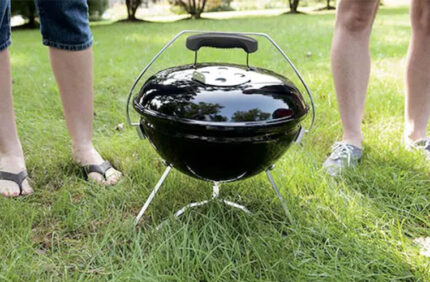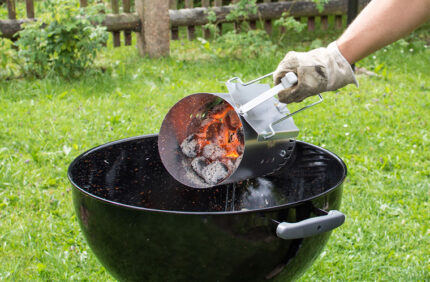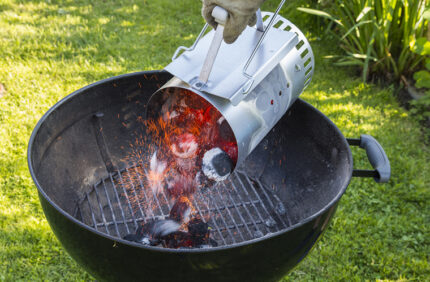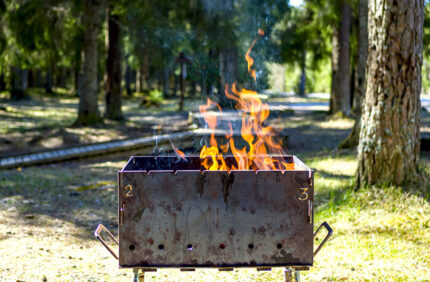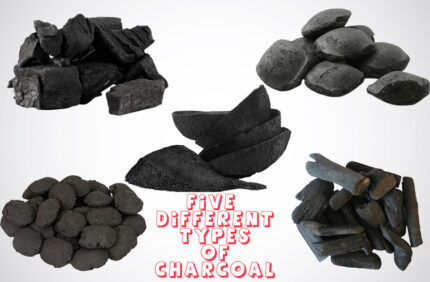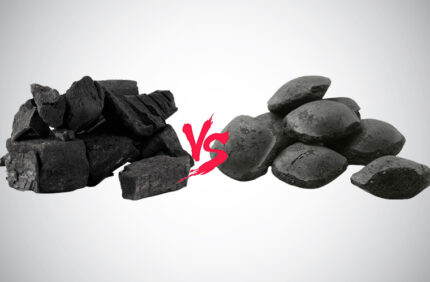With the start of the new year comes the end of winter for some of us. It’s nearly time to break out the grill and barbecue up some steaks with your family. However, this year, we’re throwing out the lighter fluid and showing you how to use a charcoal chimney starter to heat your coals.
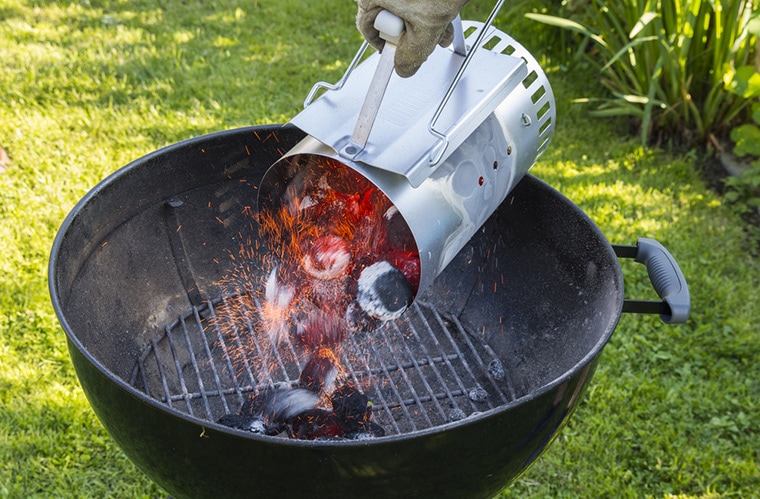
How to Use a Charcoal Chimney Starter
Before we start, you’ll need to prepare a couple of things beforehand:
- Your charcoal chimney starter (of course)
- Charcoal. You’ll need enough to fill the chimney.
- Heat-proof BBQ gloves. (If you can’t get those, you can purchase a pair of cheap heat resistant welding gloves off Amazon. They work just as well.)
- Newspaper. Alternatively, you can also get fire starters or lighter cubes.
- Your grill
- Long matches
If you have everything, then you can start learning how to use a charcoal chimney starter.
Take off the top rack of your grill and place your chimney starter on the bottom rack. It’s best to light your chimney starter here because the heat from it can melt surfaces – even concrete.
Turn your starter upside down. Fill the bottom with newspaper. If you can, you can fold two double-paged newspapers into a donut-like shape and then place them one inside the other at the bottom of your starter. This isn’t a requirement; you can also just scrunch up three newspapers and throw them in.
However, folding the newspapers into a donut shape will leave a hole at the center for more oxygen, and you may get a faster burn. But again, not completely necessary. As long as there’s ventilation at the bottom of the starter, you’ll get a good burn.
Note: You can also use fire starters or lighter cubes and forgo the newspapers. To do this, you need to set one or two cubes on the grill, light ’em up and put the chimney starter directly on them. Then, you can move forward with step three. From step three, skip stepping five directly.
Fill your chimney starter with coals. The quantity of charcoal depends on what and how much you’re cooking.
- If you’re only making a small meal, then filling it up halfway should be good enough.
- But for a huge meal of a family, then you’ll need it full.
- If you’re slow cooking, you might even need two portions.
The type of charcoal you’re using also comes into play here, but we’ll discuss why and how later.
It’s finally time. Strike a long match and fire up your newspapers from the vents at the bottom. You can also hold the lot match under the grill.
Once your newspaper is burning, all you need to do is wait. It usually takes 10 to twenty minutes for your coal to heat up well. The speed will largely depend on wind temperature and velocity. If you’re using lighter cubes, your coals might heat up a little faster. When the top coals are mostly covered in ash, they’re just about done.
Now, you should put on your heat resistant gloves and dump the coal into your grill. You can get your top rack back and place it back. Cover it and let it sit for five minutes, then remove it and scrape it clean (remember, gloves on!). And you’re ready to cook!
Lighting and Safety Tips of Using Charcoal Chimney Starter
Learning how to use a charcoal chimney starter seems easy, and it is, for the most part. However, you should pay extra attention to a couple of things to avoid any mishaps while starting a charcoal grill by chimney starters. Here are a few tips to help you keep things in order.
➡ Always wear heat resistant gloves and closed-toe shoes when handling a chimney starter. It is possible for hot coal to fall out of a chimney starter during handling or when heating. While the coal is heating, flames can arise from it, and some coal may fall out during this process. You can get a second or third-degree burn if your skin comes into contact with a stray piece.
➡ Leave some air to aid burning when you put in your newspapers.
➡ If your chimney starter is having difficulty starting blowing in the vents can help.
➡ If you’re using a shorter match, tilting the starter gently and lighting it from under the grates will be much more comfortable than using the vents. It’ll also help the starter burn quicker.
➡ Keep people away from the chimney starter when it’s in use and for a couple of hours after use. Remember that a recently used chimney starter will still be extremely hot and should be touched by bare skin.
➡ Don’t wait until all the coals at the top are completely covered in ash. If you do, chances are a few bottom pieces will have disintegrated entirely. Make sure your coals are mostly white with some black peeking through. That way, you maximize the heat while ensuring that the bottom pieces are still there.
➡ NEVER place a chimney starter on any flammable material like grass or wood. It shouldn’t be okay on concrete or tile, either. These materials aren’t flammable, but they can melt and sometimes even explode.
➡ When learning how to use a charcoal chimney starter, it might be best to use lighter cubes if it’s a windy day. Strong winds can dampen newspaper fire, and the newspaper ash might become a nuisance.
➡ Trick to make your newspaper fire last longer: Take a spray can of vegetable oil and spray it on the paper before lighting it up. This way, the paper will last longer because the fire has the burn through the oil first.
Why and How the Charcoal Varieties Influence to Using of Chimney Starter?
To an extent, yes. The type of charcoal you have should factor in when deciding what you’re cooking and how you’ll heat it.
There are mainly two type of charcoals: briquettes and hardwood lump.
Briquettes aren’t made of pure wood. They’re sawdust, packed with binders to hold them together. This kind of charcoal has uniform pieces and can be considered as the less natural but cheaper alternative. They burn evenly and comparatively slowly and are great for cooking meat with a longer cook time without busting a hole in your wallet.
Hardwood lump charcoal is 100% wood. Their irregular pieces come in different flavors – apple, pecan, mesquite, etc. – that add their own unique flavor to the food. Hardwood lump burns unevenly, very hot, and very fast. It’s great for grilling smaller meals and can be added to briquettes for a better aroma.
Hardwood lumps are more volatile and light quicker than briquettes. They also burn faster, so you should remember to add more charcoal to the starter.
So remember Briquettes for slow cooking and extra lumps for hot and fast cooking.
Conclusion
And that’s our guide! Now that you’ve learned how to use a charcoal chimney starter, it’s time to put it into practice. But remember that when you’re playing with fire, you should always keep a fire extinguisher nearby.


